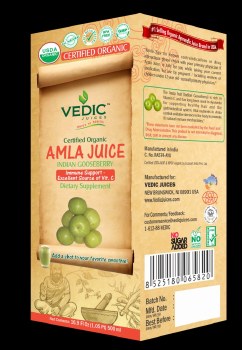VEDIC SECRETS
VEDIC ORGANIC AMLA JUICE 1LT
$14.99 $12.99 $2.00
Indian Gooseberry is a fibrous fruit that contains fibers and microfibers, which are considered vital to the nutritional value that the fruit is known for. We believe in the complete nutrition of plants and therefore we believe that simply by extracting the juice from the fruit the product is void of many of the other essential components. As our goal is to deliver a juice to the end consumer that is so nutritionally similar to real fruit that we intentionally add fiber from the fruit back to the juice. Most of our competitors simply boil the powder and add that to the water to make juice. Other companies extract the juice and then use the pulp to make other products from the pulp as a cost reduction measure. We try to provide as much nutrition as possible in our juice, and therefore the consistency of the fiber. The simple fact that an Amla fruit (Indian currant) that is only 1.0 in in diameter contains the same anti-scurvy value as two oranges and is the second richest natural source of antioxidant vitamin C is enough to attract curiosity. Amla or Indian Gooseberry (Phyllanthus emblica / Emblica officinalis) is best recognized for its richness in vitamin C. Another antioxidant found in currant juice is superoxide dismutase. SOD (superoxide dysmutasia) is an important enzyme in which many people are often deficient. This enzyme is important to rid the body of free radicals. Amla grows on a deciduous tree in the family Phyllanthaceae. The Amla fruit is almost spherical, light greenish-yellow in color, smooth and hard in appearance, with six vertical stripes or grooves. The amla flavor is best described as acidic, bitter, and astringent. According to Ayurveda, Amla is supposed to provide a cooling effect on the body. Not surprisingly, Amla is a common major component of numerous Ayurvedic preparations such as Chyawanprash.
Customer Reviews
This product has not yet been reviewed.

Share:
Share on Facebook Share on Twitter Share on Pinterest Tell a friend